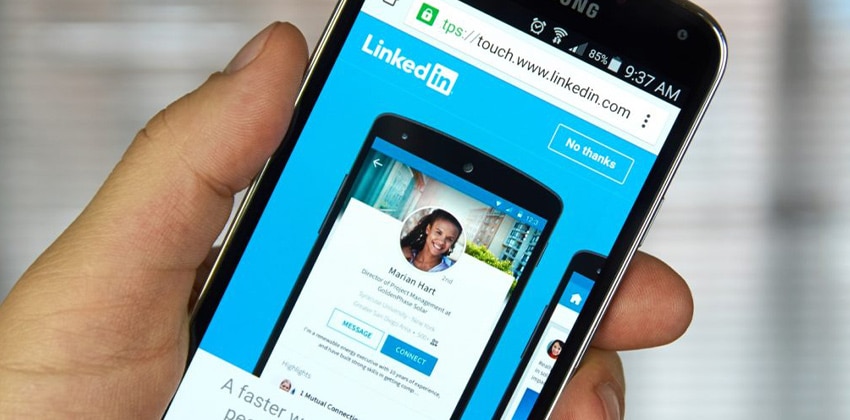
The world of job hunting is changing dramatically right now, primarily because of social media.
If you haven’t been paying attention to social media, and particularly to LinkedIn, you have some catching up to do.
Most professionals cannot afford to ignore LinkedIn today, whether or not they are in a job search. LinkedIn is a career necessity today.
I find many job seekers confuse the intelligent use of social media with a loss of privacy.
This is a serious mistake:
- An “invisible” job seeker today is one often viewed by recruiters and potential employers with some suspicion.It is rare to find no signs of online activity for someone, and lack of visibility is particularly concerning when a job seeker is not present online. Often such invisibility is a bad sign: are you out of touch, behind the times, or using a false name? [MORE: 5 Ways You Look Out-of-Date in Your Job Search.]
A CareerBuilder study released in August 2018 revealed that employers are less likely to contact an applicant they cannot find online because they “expect candidates to have an online presence.”
- In addition, you can be mistaken for someone else with the same name who has done something bad that is visible when a recruiter or potential employer researches your name online.
[Read the Guide to Online Reputation Management article for steps you can take to manage potential negatives, and read Optimizing Your LinkedIn Contact Information for a way to be easier to reach without putting your job or your privacy at risk.]
People often reveal far to much in sites like Facebook and Twitter. It is even possible with LinkedIn if you try hard enough, getting carried away with the fun of meeting new people, sharing your opinion with your peers, and making jokes.
In the most recent Jobvite.com survey, 93% of recruiters indicated that they were likely to look at a candidate’s social profile, and 42% of those recruiters have reconsidered a candidate based on what they found – both positive and negative.
LinkedIn: the Preferred Social Network for Hiring
With nearly 650 million members in over 200 countries (in Q4, 2019), LinkedIn is the most “grown-up” and professional of the social media network venues currently available.
Particularly in comparison with Facebook, LinkedIn is respectful of member privacy.
According to the Jobvite recruiter survey, the use of social media for recruiting has been expanding, and the trend is expected to continue.
LinkedIn is clearly in the lead in many ways.
Hiring: When it comes to hiring, 78% of recruiters have hired through a social network, and the leading network for hiring is LinkedIn by a very wide margin (see the image below). While 92% of recruiters have hired through LinkedIn, only 24% have hired through Facebook, and 14% have hired through Twitter.
 Recruiting: Most of the 94% of recruiters who use (or will use) social networks for recruiting will be using LinkedIn.
Recruiting: Most of the 94% of recruiters who use (or will use) social networks for recruiting will be using LinkedIn.
The preference for LinkedIn is significant with 94% of the “social” recruiters using it vs. 65% of social recruiters using Facebook and 55% of social recruiters using Twitter.
LinkedIn is the most popular site for recruiters by far, as the data below reveals.
Of the social recruiters, LinkedIn clearly dominates in key uses, according to a recent Jobvite survey:
- 95% of recruiters use LinkedIn to search for candidates.
- 95% use LinkedIn to contact candidates.
- 93% use LinkedIn to “keep tabs on” potential candidates.
- 93% use LinkedIn to “vet candidates pre-interview” (vs. 32% on Facebook and 18% on Twitter).
- 92% posted jobs on LinkedIn (vs. 48% on Facebook and 39% on Twitter).
Recruiters indicated that they checked a candidate’s LinkedIn Profile for:
- Professional experience
- Length of professional tenure
- Specific hard skills
So, investing time in learning how to leverage social media for your job search, and to leverage LinkedIn, in particular, will be time well spent for you.
Do remember that social networks are just another method for people to connect. You will need more than a LinkedIn Profile.
Share, like, and comment in LinkedIn Updates and participate intelligently and carefully in LinkedIn Groups to establish an appropriate on-brand presence for yourself.
Then, connect with other human beings, off-line, usually to close the deal and land the job.
As with all the social media, technology and the best methods of leveraging technology changes often. This section of Job-Hunt will help you stay current with LinkedIn.
Your Solid Base: An All-Star LinkedIn Profile
An “All-Star Profile” (a.k.a. “complete Profile”) is unavoidable for successful visibility and credibility on LinkedIn. A complete LinkedIn Profile gives you the capability to include the keywords that are essential for your job search.
An All-Star Profile has these elements:
- A Profile photo —
This photo should be only you (no kids, friends, or pets), looking friendly, and dressed appropriately for your profession. Do NOT avoid including this photo! Without a photo on your Profile, it is invisible. - Your Professional Headline —
The Headline for your Profile should be accurate, descriptive, and more than simply your job title and employer name (the default). The Headline is an essential element of a successful LinkedIn Profile. Read Fast Formula for a Powerful LinkedIn Headline for more information. - Your location —
For LinkedIn, your location is a city and state or region, not your address! - An up-to-date current position —
LinkedIn gives you 2,000 spaces, so you can and should describe the position in as much detail as possible. Focus on your accomplishments, which are much more than a bulleted list of “responsible for” items. Also describe your employer unless it is an extremely well-known organization. - Two past positions —
Again, describe each position in detail to include important keywords like job titles and skills. Like the current position, you have 2,000 spaces to use for each of your other jobs, too. Highlight your successes as well as those of your employer. - Your education —
Include college degrees (or years in college), certifications, and other relevant professional training. Read Hidden LinkedIn Networking Tool: Education to learn more about leveraging your schools for your job search. - Your skills (minimum of 3) —
Choose the ones most relevant to you and your profession. Read 5 Steps to Leverage LinkedIn Skills & Endorsements for a More Powerful Profile to understand how to choose and leverage Skills most effectively. - At least 50 connections —
And more are definitely better, of course, because you become more visible in LinkedIn search results based on the size of your LinkedIn network. If you are not in someone’s network (first, second, or third degree connection), you won’t be visible to them unless they have a premium/paid account. - Contact information —
The best LinkedIn Profile is ineffective if, when you are found by a recruiter, they have no way to contact you unless they are a connection or pay for a premium account. And more are definitely better, of course, because you become more visible in LinkedIn search results based on the size of your LinkedIn network. If you are not in someone’s network (first, second, or third degree connection), you won’t be visible to them unless they have a premium/paid account.
To understand more about including the right keywords in your LinkedIn Profile, read Linkedin SEO: How to Be Found by Recruiters on LinkedIn and our FREE eBook: Smart Personal Branding with LinkedIn.
Once your Profile is completed, focus on keeping it up-to-date. Tweak your keywords to be current, reflecting your accomplishments and focus on the job you want next.
Stay Active: Visible and Reachable
What you share is visible on your LinkedIn Profile in a section above the Experience section of your Profile titled, “Activity.”
People who are considering hiring you may look to see what you are publishing and sharing on LinkedIn. Keep those folks in mind when you write an article and publish it on LinkedIn. Also, remember them when you hit the “Like” button on someone’s post.
Being active on LinkedIn tells recruiters that you are reachable and, probably, responsive if they do reach out. Hopefully, your activity also demonstrates your written communications skills and proves that you are a knowledgeable and intelligent person who is up-to-date in your field. For more information, read How to Leverage LinkedIn Status Updates for Your Job Search.
When you are visible, also be easily contacted. Carefully, make contact information visible on your Profile. This allows recruiters, who are always in a hurry, to quickly reach out to you, whether or not they pay LinkedIn for a premium account. Read Optimizing Your LinkedIn Contact Information for a way to be easier to reach without putting your job or your privacy at risk.
More About LinkedIn for Job Search
- 10 Elements of an Effective LinkedIn Profile
- 5 Secrets to a Knockout LinkedIn Profile Summary
- Fast Formula for a Powerful LinkedIn Professional Headline
- Why You Need a Photo on Your LinkedIn Profile
- Grab Recruiter Attention with Skills
- LinkedIn SEO (Search Engine Optimization)
 About the author…
About the author…
Online job search expert Susan P. Joyce has been observing the online job search world and teaching online job search skills since 1995. A veteran of the United States Marine Corps and a recent Visiting Scholar at the MIT Sloan School of Management, Susan is a two-time layoff “graduate” who has worked in human resources at Harvard University and in a compensation consulting firm. Since 1998, Susan has been editor and publisher of Job-Hunt.org. Follow Susan on Twitter at @jobhuntorg and on Facebook, LinkedIn.
More about this author…
Don't forget to share this article with friends!




